#Deep State Toolkit
Explore tagged Tumblr posts
Text
Unmasking the Deep State Toolkit
What are your thoughts on the Deep State Toolkit allegations? Share your views in the comments below!
Unmasking the Deep State Toolkit: The Haryana Elections and Indian DemocracyDecoding the Deep State ToolkitWhat is the Deep State?Deep State Conspiracy Theories: A Global PhenomenonDeep State Toolkit: The Alleged Modus OperandiDeep State Toolkit in the Haryana Elections: Fact or Fiction?Congress’s Alleged Adoption of the ToolkitD K Dubey’s Legal Analysis: Separating Truth from SpeculationThe…
#Congress#Data Mining#Deep State Toolkit#Electoral Integrity#Haryana Elections#Indian Democracy#Judicial Reform#media manipulation#misinformation#Political Manipulation#Vinesh Phogat
0 notes
Text
NAVIGATING DOUBT when manifesting/shifting.





i’ve reached a pretty comfortable place when it comes to doubts, so i wanted to share a few things that have helped me actualize this mentality. please note i am not claiming these approaches are infallible. it's going to vary person to person and even moment to moment, but i know that sometimes, having a toolkit to fall back on can be helpful!
WHAT ARE DOUBTS? doubts are just you putting your awareness on what you don't want. like everything in existence, doubts are simply something you are/can be aware of—a cloud floating through the sky of awareness. now, i know they don't always feel like that, and i'll get to more on that in a second here, but first, let's establish that doubts are just something to be aware of, like everything else in existence.
DO DOUBTS AUTOMATICALLY "MANIFEST?" thoughts alone do not "manifest." if they did, every thought you've ever had would have materialized physically, and life would be chaos. what does make itself seen in physicality—from a free coffee to a whole new reality—is who you are conscious of being or, in other words, awareness plus identification. what do you ascribe to be true about you/reality?
this is why doubts can feel so "real." you're used to having your awareness on a self who doesn't get what they want, has to effort hard to receive very little, is unstable/unsafe, always fails at shifting/manifesting, or is otherwise lacking or incomplete in some way. so, when you have a thought that your desire won't manifest or you won't wake up in your DR, it feels real to you because it is real to/is in alignment with the self you've identified with.
HOW TO "DEAL WITH" DOUBTS. when you're in the mindset that your doubts are something you have deal with, fight, or eradicate, you create a hydra out of them—chop off one head and more appear. this is because you're putting your awareness on the self who has to fight doubts, and thus, more doubts arise (i.e., manifest) for you to fight.
in my experience of self, fighting has never gotten me anything other than exhaustion, be it mental or physical. the answer was always in softening. as the ancient one said to stephen strange, "you cannot beat a river into submission. you have to surrender to its current, and use its power as your own."
what does this look like with doubts? first, remember that doubts are just something to be aware of. they're entirely neutral until you give them power. as jesus said to pontius pilate, "you could have no power at all against me unless it had been given you from above." your doubts have no inherent power until you've given your power to them because you, your light of awareness, are the sole power in your individualized reality.
when i become aware that my awareness is on doubts, i often like to remind myself, "i remember when i was doubting if it would happen, and here it is. the doubts meant nothing." this helps me frame my doubts from the perspective of fulfillment.
of course, i also know that not all doubts can be easily dismissed. the way you navigate doubt is often dependent on how closely you've identified with them, and that's why i wrote the disclaimer at the beginning. if you feel so deeply stuck, my recommendation is to either:
find a way to self-soothe. take deep breaths. take a nap. listen to music. take a shower. do something that will help you get to a better emotional state. really, take care of yourself as best as you can with the resources you have immediately available to you. this too shall pass; these awful feelings won't last forever. be kind and gentle with yourself.
put your focus on anything else. watch a super engaging tv show, play a challenging video game, or learn calculus for all i care. just put your awareness on something else by completely consuming your focus with the new task at hand.
stop trying. this is the law of paradoxical intent: the harder you try toward something, the more difficult it can be to attain/the more separate you perceive yourself from your goal. instead of pushing against them, drop the trying and just let them be. don't resist your doubts. let them exist and yap like you would an annoying sibling, but you don't have to give them your attention and focus. honestly, you could even give your doubts a name and personify them as a way to de-identify from them and brush them off. "oh, that's just steve. steve is always worried about stuff that doesn't matter." obviously, if your name is steve (a) sorry and (b) name them something else. i also recommend naming the doubter after a character who worries about stuff that never comes to fruition.
when the storm passes through your awareness and you reach a state of greater emotional and mental clarity, choose again. affirm, visualize, script, decide, or whatever manifesting/shifting means to you. be it now. choose it now. decide it now. there's only one moment anyway. when the doubts are "in the past," they only exist in your awareness of what you prescribe the past to be. so, weather the storm, then choose your desired self when you're ready to.
YOUR DOUBTS CAN SERVE YOU. it can be easy to get caught up in the "dealing with doubts" narrative, that you can forget these doubts are just you. everything is you. so, if your doubts are you, they're actually showing you who are you, and there's a ton of information you can glean from them with a keen eye: study them.
get curious, open, and inquisitive, and try to observe the narrative these doubts are telling from an objective perspective. this can be an incredibly beneficial process because it can bring some unconscious assumptions up to the light of your conscious awareness, thus empowering you to shift your assumptions at the root instead of trying to brute force yourself into a better state. if your doubts keep telling the same story over and over again, what are they revealing to you about what you fundamentally believe about yourself?
people in this community can rush to deny doubts so damn fast, but if it's a persistent challenge "dealing with them," then i really do implore people to get self-reflective. i was able to radically shift my consciousness around a few areas of my life when i realized my doubts were a product of an underlying assumption that i wasn't safe in this world, and when i brought that underlying assumption to the surface of my conscious awareness, i was empowered with the opportunity to choose a new narrative: i am safe, i am secure, i am provided for, and i am safe in my body. now, doubts that were formerly connected to this old story don't pester me as much, both in frequency and intensity.
i also started seeing my doubts as fulfillment. you don't know you were on the bridge of incidents until you get to the end. there were times when i would have this nagging anxiety about something, i would get up and take action because i was a ball of jittery energy, only to find out retrospectively that that was the thing that would lead me to exactly what i wanted. i started doubting my doubts less after this happened a couple times, tbh, and i really just let them be what they are, while putting my greater trust in total fulfillment.
YOU ARE NOT YOUR DOUBTS. your doubts are just passing through your awareness, the true you. if manifesting/shifting is a matter of awareness and identification, navigating doubts is just the opposite: reducing the presence of doubts in your awareness by putting your awareness on what you want over what you don't want and de-identifying with the self who is not fulfilled.
doubts are not permanent, but you are eternal. they have no power over you and neither are you a victim to them. let them be. let them pass. and continue to remind yourself: it's already done. it's already yours. everything is already perfect, including you. you are perfect, and you have always been perfect. it's just a matter of remembering the perfection you already are.
#j's masterlist.#law of assumption#loassumption#loa tumblr#loablr#manifesation#manifestation motivation#manifestation tips#reality shifting#shifting community#shifting blog#shiftblr#shifting tips
150 notes
·
View notes
Text
svt & love poems they'd give you.

★ footnotes: decided to marry the two halves of my heart this valentine's: svt and poetry. this is unashamedly inspired by the brilliant @heartepub, whose constant intersection of svt x poetry inspires me to no end. viv, you are an entire poem in itself; i would give you all the pretty words in the world, if i could. + happy carat day, everyone!


seungcheol ★ Isn't Every Love Poem an Unfinished Love Poem?, Cristin O'Keefe Aptowicz
Praise the caps of your shoulders, my lips pressed against them.
Praise the poem I was trying to finish when you showed up
at my door.

jeonghan ★ If I Had Three Lives, Sarah Russell
If I had three lives, I'd marry you in two. The other? Perhaps that life over there at Starbucks, sitting alone, writing—a memoir, maybe a novel or this poem. […] I'd walk the beach at sunrise, find perfect shell spirals and study pockmarks water makes in sand. And I'd wonder sometimes if I'd ever find you.

joshua ★ True Love, Sharon Olds
I quietly call to you and you come and hold my hand and I say I cannot see beyond it. I cannot see beyond it.

junhui ★ February & my love is in another state, José Olivarez
stay with me. while the sky is still golden, hold the ladder so i can climb, & from the highest rung, i can scrape away a drizzle of light to wear around my neck. alone
is the star i follow. in love & in solitude: alone is the home with the warmest glow.

soonyoung ★ Variations on the Word Love, Margaret Atwood
This word is far too short for us, it has only four letters, too sparse to fill those deep bare vacuums between the stars that press on us with their deafness. It's not love we don't wish to fall into, but that fear. this word is not enough but it will have to do.

wonwoo ★ The Leash, Ada Limón
But sometimes, I swear I hear it, the wound closing like a rusted-over garage door, and I can still move my living limbs into the world without too much pain, can still marvel at how the dog runs straight toward the pickup trucks break-necking down the road, because she thinks she loves them, because she’s sure, without a doubt, that the loud roaring things will love her back,

jihoon ★ You Do Not Have To Love Me, Leonard Cohen
I wrote all these songs for you I burned red and black candles shaped like a man and a woman I married the smoke of two pyramids of sandalwood I prayed for you I prayed that you would love me and that you would not love me

seokmin ★ Watching you talk on the phone, I consider the empty space around atoms–, Rhiannon McGavin
To make my birthday cake from scratch, you wouldn’t just plant strawberries: you’d create another universe. I wanted you
warm and close as fresh laundry and here we are, Tuesday. Of course you love me, you’re wearing one of my socks.

mingyu ★ O Small Sad Ecstasy of Love, Anne Carson
I did a road trip all over my mind and heart and there you were kneeling by the roadside with your little toolkit fixing something.
Give me a world, you have taken the world I was.

minghao ★ The Quiet World, Jeffrey McDaniel
Late at night, I call my long distance lover, proudly say I only used fifty-nine today. I saved the rest for you.
When she doesn’t respond, I know she’s used up all her words, so I slowly whisper I love you thirty-two and a third times.

seungkwan ★ A Walk Round the Park, Sandra Lim
We did not say much to each other but
we grinned, because this love was so good you sucked the
rib bones
and I licked my fingers like a cat.
Now I’m omniscient. I’m going to skip past
the hard
parts that go on for a very long time.

vernon ★ Guilty of Dust, Frank Bidart
the voice in my head said
LOVE IS THE DISTANCE BETWEEN YOU AND WHAT YOU LOVE
WHAT YOU LOVE IS YOUR FATE

chan ★ First Date, Megan Williams
I want the warmth of your gaze to convince me that living is worth the discomfort. That other people can like me. That the bottlenecked bridge full of squealing tires & suckers who can't merge is a small price to pay for a hand in mine.
#svt imagines#svt scenarios#seventeen imagines#seventeen scenarios#once again: not much to tag since this is my personal little love letter for the boys 💌#poetry x svt circles how i love u so!!!#(🥡) notebook#(💎) page: svt
72 notes
·
View notes
Text
Dangancember 2024 - Danganronpa Top 24 Class Trials - NUMBER 2🥈: Danganronpa 2 Case 5
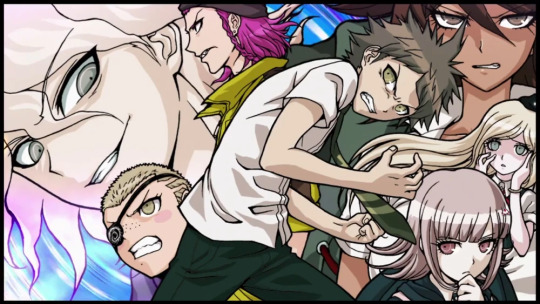
//I'm willing to bet that almost EVERYBODY thought this one was going to get Number 1 on this list, and to be fair, when I did a ranking years back, it DID get the reward for my best case back on Reddit.
//But in case this list, compared to that one, isn't evidence enough, my opinions have changed a bit.
//I feel the need to remind everyone that this ranking is based primarily on my general feeling of each of these cases, taking into account the characterization, investigation, general mystery, plot twists, etc. If we were ranking this purely on investigation and mystery, without my personal feelings towards a case involved, this one would be Number 1.
//When it comes to Danganronpa cases, Game 2 Case 5 is not just the crown jewel; it’s the one everyone expects to see perched at the top of any "best trials" list.
//And yes, I hear you already, "Oh, how predictable. Case 5 at the top? How original!"
//But let’s face it, sometimes the popular opinion is popular for a reason. I don’t do contrarianism for sport, folks. If something’s obvious because it’s correct, then I’m not going to waste time pretending otherwise.
//Could I have slapped some other case here, like 1-2 or V3-1, to make things spicy? I think it's spicy enough that this one isn't Number 1, but that aside, we’re not here for hot takes; we’re here to appreciate brilliance, and Case 5 is absolutely, unequivocally, that case.
//Now, let’s address the elephant in the room, or perhaps the giant robotic animal mascot if we’re staying on brand. This case is legendary for reasons beyond just "it’s good."
//Put simply, there is no other video game or mystery-themed franchise that could pull this case off OTHER than DANGANRONPA.
//It’s part mystery, part madness, and 100% the kind of twist-riddled storytelling that no one can replicate. You’d need the full chaotic toolkit of Danganronpa’s narrative rule-breaking, character complexity, and absurd-but-brilliant logic leaps. Without those, you’re just a murder mystery fan with a dream.
//Why does this case stand out so much? Because it takes what we think we know about how these games work, how mysteries work, really, and throws it straight into Monokuma’s metaphorical incinerator. In most murder mysteries, the setup is fairly predictable: Person A offs Person B, usually for some selfish reason, like wanting freedom or holding a grudge.
//Danganronpa usually follows that formula, with the added twist of a deadly game show setting. But then along comes Case 5, flipping the script so hard it leaves you reeling. It doesn’t just upend expectations; it takes them out back, ties them to a rocket, and blasts them into space.
//And yet, it’s not just shock value. Beneath the twists and turns, this trial is meticulously crafted, intertwining its revelations with the overarching story in ways that make your brain do somersaults. It’s equal parts emotionally devastating and intellectually satisfying. If you’re a fan of intricate mysteries and gut-punching twists, this case isn’t just going to impress you, it’s going to live rent-free in your mind forever.
But don’t take my word for it (well, okay, do, since you’re reading my review). This case’s reputation precedes it. If you’ve played it, you know. And if you haven’t…well, let’s just say, the bar for storytelling in murder mystery games is about to be set unreachably high.
//Let's dive in!

//Let’s be real: by this point in time, you’re knee-deep into this game, so many are dead, and you know something’s about to go down with Nagito Komaeda. The ominous buildup and his increasingly unhinged behavior practically scream, “Buckle up, this is gonna get wild.”
//So when you eventually stumble upon his body, it’s not exactly shocking that he’s the victim. What is shocking, however, is everything else about this chapter. The setup, the stakes, the twists, and oh boy, the absolutely brutal state of his corpse. Seriously, if you thought previous trials in this game had upped the ante, Chapter 5 snaps the bar in two and sets it on fire for good measure.
//The setup alone is chaos incarnate: Nagito has hidden bombs around Jabberwock Island and cheerfully announces that if they go off, the entire island and everyone on it will sink straight into the ocean. Naturally, this sends the remaining students—Hajime, Chiaki, Fuyuhiko, Akane, Kazuichi, and Sonia—into panic mode as they scramble to defuse them.
//Just when they manage to avert what feels like certain doom, they discover a warehouse is suddenly engulfed in flames. Conveniently (or suspiciously?), fire grenades are nearby, and the group decides to toss them into the inferno in an attempt to extinguish it.
//Crisis averted, right?
//Wrong.
//When the smoke clears, they find Nagito’s lifeless body inside, and it’s unlike anything the series has thrown at you before.

//Let’s talk about that body discovery scene because…wow. Danganronpa doesn’t shy away from gruesome, but Nagito’s death takes the cake. His body is covered in cuts, there’s a knife stabbed straight through his right hand, and, as the pièce de résistance, a massive spear is impaled directly through his chest. It’s horrifying, grotesque, and easily one of the most graphic and unforgettable discoveries in the entire series. If you’re not audibly gasping by this point, you might need to check your pulse.
//But here’s where things get really interesting: despite being the victim, Nagito is also the villain of this chapter. His death isn’t just the result of some random grudge or desperation; it’s an intricately planned act designed to manipulate and torment everyone left alive.
//It’s peak Nagito. Brilliant, twisted, and utterly maddening.
//I don't know if I can talk about Nagito himself without repeating things that I've already said, because he’s come up multiple times in this countdown already (and spoiler alert, he’s not done yet), and for good reason.
//Calling him "memorable" feels like the understatement of the century. This guy is the embodiment of chaos, and his very existence has transcended the game to become a full-blown meme.
//But there’s a reason for that: Nagito isn’t just weird; he’s fascinating. He’s the kind of character who sticks in your brain long after the credits roll, equal parts horrifying and hypnotic.
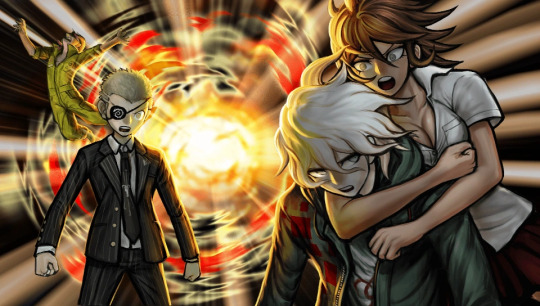
//What makes Nagito so unique is his complexity. On the surface, he seems like an unassuming guy with a fairly mundane talent. But peel back the layers, and you’ll find one of the most manipulative, unsettling, and downright creepy characters in gaming history. His self-loathing is palpable, but it’s overshadowed by his ability to twist every situation to his advantage, or just to create absolute bedlam at ease.
//He’s so committed to his warped version of "hope" that he’s willing to employ the most extreme, morally dubious methods to achieve it. In many ways, he’s the second game’s true antagonist, even if he doesn’t fit the traditional mold. Fuck Junko and Izuru.
//And Case 5 is essentially Nagito’s magnum opus. It’s the culmination of everything that makes him such a standout character: his intelligence, his unpredictability, his disturbing charisma, and his willingness to do whatever it takes, even die, to prove his point. The result is a chapter that feels less like a murder mystery and more like an elaborate psychological chess match.
//So, while Chapter 5 might technically be about solving Nagito’s death, it’s really about unraveling Nagito himself. His influence permeates every aspect of the case, making it one of the most unforgettable and genre-defining moments in Danganronpa history.
//The investigation is okay, but again, as I said for 1-2, it's how they all culminate into the trial that it really works, so let's not waste any more time, and actually get into talking about that.
//For starters, I want to say that the pacing of this trial is BRILLIANT. Every twist and turn feels meticulously timed to keep you on the edge of your seat, while the ideas introduced all tie into the case’s central themes, on top of being innately shocking.
//When the students first discover Nagito’s body, the sheer brutality of the scene makes it look like he was tortured for information before being killed. There are cuts all over his body, a knife impaled through his hand, and that massive spear skewering his chest like the world’s most horrifying centerpiece. It screams “murder most foul,” and naturally, the students start theorizing about who could’ve done something so horrific.
//But quickly, they realize that it wouldn't make sense for someone torture Nagito for information if his mouth was duct-taped shut. Though Kazuichi especially argues for it, that one little detail flips the entire narrative on its head. If he couldn’t speak, then the torture couldn’t have been for interrogation.
//The students realize this, and their next leap in logic is to suspect that maybe Nagito wasn’t murdered at all. What if he orchestrated his own death?
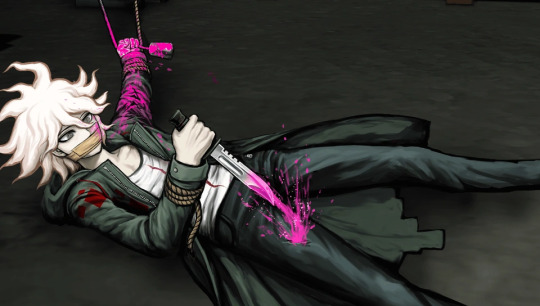
//After all, this is Nagito we’re talking about, a guy who thrives on chaos and has a disturbingly cavalier attitude toward his own life. Using the rope attached to the spear, it seems plausible that he could’ve rigged a setup to drop the weapon onto himself, making it look like an elaborate suicide.
//This is...somewhat true. But in true Danganronpa fashion, the obvious answer is never the correct one. The suicide theory falls apart under closer scrutiny, leaving the students, and the player, scrambling for answers.
That’s when the horrifying truth comes to light, and boy, does it hit like that fire truck that killed Celeste.
//Nagito set up the scene so that the warehouse he died in would catch on fire once the students opened the door. To get through, the rest of the group grapped a bunch of fire grenades to put the fire out, and all of them grabbed at least one, and threw it into the flames.
//However, this single act causes them to plummet head first into the trap that had been set for them.

//Nagito, ever the agent of chaos, actually rigged one of the fire grenades with lethal poison gas. When the students threw the grenades to extinguish the warehouse fire, one of them tossed the poison grenade, dispersing the gas and killing him. Suddenly, what seemed like a murder mystery or a suicide case becomes something far more twisted.
//And here’s the kicker: nobody knows who threw the poison grenade. Not even the person who actually did it!
//By mixing the poison grenade with the others, Nagito ensured that the identity of his killer would be COMPLETELY RANDOM. This wasn’t just a murder; it was a gamble, a deadly game of Russian roulette where none of the participants even knew they were playing. As I said it’s the kind of mind-bending twist that only Danganronpa could pull off, and it perfectly encapsulates Nagito’s philosophy of chaotic hope.
//Monokuma obviously knows which student threw the poisoned grenade as well, and obviously, if the students get it wrong, they are ALL SCREWED.
//The brilliance of this setup is how utterly hopeless it makes the trial feel. Class trials are all about deduction, piecing together clues, and eventually uncovering the truth. But how do you solve a case where even the killer doesn’t know they’re the killer?
//For the first time in the series, it feels like there’s no way forward, no light at the end of the tunnel. The murder is, quite literally, impossible to solve using traditional methods. It’s a masterstroke in subverting the player’s expectations while also reinforcing the themes of despair and uncertainty that define the series.
//This moment also highlights why Nagito is such a standout character. Only he could come up with something so convoluted, so meticulously planned, and yet so chaotic at its core. He turns the class trial, a system designed to uncover truth and punish the guilty, into an instrument of despair.
//By making the killer’s identity random, Nagito forces the group to confront the idea that justice might not always be attainable. It’s a chilling reminder of how far he’s willing to go to prove his warped ideals about Hope and Despair.
//Thematically, this case is a perfect storm. It pushes the students to their absolute limits, not just intellectually but emotionally as well. How do you come to terms with a murder that has no clear perpetrator? How do you move forward when the very foundations of the game’s rules have been shaken?

//The trial becomes less about solving the mystery and more about grappling with the moral and philosophical questions it raises. It’s a level of depth and complexity that sets it apart from anything else in the series.
//Of course, this wouldn’t be a Danganronpa trial without a good dose of drama and tension. Watching the students wrestle with their guilt, fear, and confusion as they try to piece together the puzzle from start to finish, and then reach the absolutely horrifying situation they land in, is both heartbreaking and riveting. The stakes, genuinely, never reach higher than this, and the outcome feels completely uncertain and TERRIFYING.
//By the time the truth is revealed, you’re left in awe of the sheer audacity of the writing. It’s the kind of storytelling that leaves a lasting impression, long after the game is over.
//Ultimately, what makes this so effective is how it combines narrative brilliance with gameplay innovation. It’s not just about what happens, but how it makes you feel as a player. You’re questioning everything you thought you knew about how these trials work. It’s a case that breaks the rules, challenges your expectations, and delivers a story that’s as thought-provoking as it is shocking.
//But if you thought we were done, no, we aren't quite yet. What comes after this kicks the trial into a, somehow, HIGHER gear.
//Despite Nagito’s seemingly impossible-to-solve murder, the students DO manage to piece together the truth. And the resolution is haunting, depressing, and brilliantly layered, as it ties back to one of the game’s longest-running mysteries:
//The identity of the traitor.

//Monokuma drops the first breadcrumb early in the story, mentioning that the island was prepared for specifically 15 students but somehow, this group ended up with 16.
//This anomaly immediately plants the suspicion that one of the students is a traitor working for, what we eventually discover, is the supposedly evil "World Ender Organization." It’s a mystery that looms over the entire game, and Nagito, being Nagito, becomes obsessed with uncovering the truth.
//This obsession drives much of Nagito’s increasingly erratic behavior. His bizarre stunts, from his cryptic speeches to the explosive warehouse gambit, are all rooted in his desperation to expose the traitor. Though his motives aren't quite what they seem.
//The events of Chapter 5 are essentially his ultimate gambit for this mission: an elaborate plan to force the traitor to reveal themselves by staging an unsolvable murder.
//But this isn’t just about solving a mystery. Nagito, in his twisted logic, decides that sacrificing himself is a small price to pay if it means exposing the traitor and their connection to the World Ender. If everyone else has to die as collateral damage? Well, that’s just fine with him. It’s peak Nagito, both brilliant and horrifying.
//But...if this plan is at risk of killing everyone, and the poisoned grenade was thrown by a random person, how exactly was it supposed to work?
//What makes this trial so exceptional is how it builds on a recurring theme in Danganronpa 2: the way characters use their Ultimate Talents to achieve their goals. Each case in the game showcases this idea in unique ways.
Teruteru uses his cooking skills to conceal a murder weapon.
Peko exploits her swordsmanship to stage a clever escape.
Mikan manipulates her role as a nurse to fabricate an alibi.
Gundham weaponizes his hamsters to immobilize his victim.

//But this trial falls into this theme while also switching it up, by making the victim the one who uses their talent to manipulate the outcome. And Nagito’s Ultimate Lucky Student talent once again takes center stage, and its application here is as ingenious as it is unsettling.
//Nagito’s luck is unlike Makoto’s relatively tame version in the first game. It’s tangible, almost supernatural, and eerily consistent. Whether it’s winning a game of Russian Roulette with an almost fully loaded revolver in Chapter 4 or orchestrating the chaos of this trial, Nagito’s luck always seems to tilt events in his favor, even when it’s to his detriment.
//This trial showcases his mastery of his talent, as he uses it to create a scenario so convoluted that solving it requires an extraordinary leap of faith. It’s a testament to how his character embodies the unpredictable nature of luck, both as a tool and as a weapon.
//When the students are left with no other options, Hajime proposes a bold theory: the person Nagito was targeting with his poison grenade must be the traitor. With the clock ticking and no clear path forward, the group takes a gamble and calls for the traitor to reveal themselves. And here’s where the trial delivers one of its most gut-wrenching twists.
//Instead of the group uncovering the traitor through deduction, the traitor steps forward voluntarily. It’s Chiaki Nanami, the Ultimate Gamer and a beloved figure in the story.

//Chiaki’s betrayal is particularly heartbreaking because of how central she’s been to the trial system in Danganronpa 2. She is effectively Hajime's equivelant to what Kyoko was for Makoto, being his closest ally, and often providing critical insights and support during investigations and debates. Her calm demeanor and love for her friends make her an endearing presence, so her reveal as the traitor feels like a betrayal not just to the characters but to the player as well.
//Even if I've always felt Chiaki might be a bit overrated, it’s hard not for me to feel a pang of sadness as the truth comes to light. And yet, this reveal also solidifies the brilliance of Nagito’s plan. His twisted methods worked: he exposed the traitor, even at the cost of his own life.
//Genuinely, the reaction to Chiaki stepping forward as the traitor is one of the most soul-crushing scenes in the game thus far, and for good reason.

//Chiaki is the most perfect candidate to play the role of the final killer in this game, because she’s the one student on the island that everyone universally adores. She’s the epitome of the "can do no wrong" character. Which for me personally, is something I've never liked about her, but it does work in the buildup to this revelation.
//She’s sweet, dependable, and always there to lend a hand during trials with her sharp insights and calm demeanor, just as her supposed "father" Chihiro was. The same applies to Kaito in V3, as he's the universally loved wildcard who shoulders a heavy emotional weight heading into the endgame.
//So, when Chiaki confesses to being the traitor and asks the group to vote for her so they can save themselves, her classmates react in the most predictable way possible: absolute, unrelenting denial.

//Instead of nodding grimly and doing what needs to be done like every other time, they outright refuse, dragging their heels like stubborn toddlers who don’t want to eat their vegetables. Watching this unfold is both heartbreaking and oddly hilarious, as it highlights just how much the group collectively loves her.
//Hajime, bless his poor, conflicted soul, finds himself in the unenviable position of having to convince the group to face reality. This includes arguing against everyone, particularly against Sonia, who is especially resistant to the idea.
//Imagine trying to sell an unflattering truth about someone universally beloved while standing in a room full of people who would rather rewrite history than accept it. That’s exactly what Hajime has to do. Everyone goes to great lengths to deny Chiaki’s guilt, even twisting their earlier testimony to absolve Chiaki, and it’s like watching a courtroom drama where the defense lawyer loves their client so much they’re trying to argue the laws of physics out of existence.
//What makes this sequence so powerful is how the game adjusts its tone and pacing to reflect the emotional gravity of the situation. The trial’s usual high-energy minigames, complete with intense, upbeat tones and kickass music, suddenly shift into something quieter, heavier.

//Take Sonia’s Rebuttal Showdown, for instance. The usual sword-clashing music is replaced with a somber track, setting a melancholic mood. This silence isn’t just an absence of sound, it’s a deafening reminder of the emotional stakes at play.
//Even Hajime’s iconic "No, that’s wrong!" line is replaced by more desperate, sorrowful dialogue, hammering home the fact that despite arguing against, her, he, above EVERYBODY ELSE HERE, wants to accuse Chiaki THE LEAST.
//But he knows he must. She’s essentially asking him to kill her so that the others can live, and he’s left with no choice but to comply. It's tragic, raw, and incredibly effective storytelling.
//As if the emotional gut punches weren’t enough, the trial then drops a bombshell about the overarching narrative: the Future Foundation, which had been framed as the antagonist group, are actually the good guys. Chiaki and Monomi, as their representative, was working against Despair all along.
//This twist retroactively reframes the story, making Chiaki’s betrayal feel even more bittersweet. Monomi’s steadfast support of the group also takes on a new light, as her actions were driven by a desire to protect them, not manipulate them like they all believed. It’s the kind of twist that makes you sit back and rethink everything you’ve assumed about the game up to this point.
//And then there’s Nagito, whose insane brilliance looms large over this trial. At first, his actions seem designed to expose Chiaki as the traitor and ensure her execution. But after the trial, it becomes clear that his motives were far more complex, and arguably even more unhinged.

//After discovering that the other students were former Remnants of Despair, key players in Junko Enoshima’s plans, Nagito developed an intense self-loathing and a burning hatred for his classmates that completely paralleled his initial admiration of them. In a bizarre twist of logic, he decided the traitor was the only good person among them and concocted this elaborate trap to ensure their survival.
//Nagito’s plan, of course, hinges on his Ultimate Luck, which he uses to make the trial seemingly impossible to solve, and his hope was that Chiaki, as the traitor, would survive by default while the rest of the group received a wrong verdict and were executed. It’s a plan so convoluted and morally dubious that you almost have to admire the audacity of it.
//However, it’s also hilariously short-sighted upon reflection. Killing everyone except Chiaki would have effectively handed victory to AI Junko, whose goal was to plunge the world into even greater Despair. Of course, Nagito had no way of knowing that, but it's still funny to think about that had Hajime and Chiaki not been able to stop his plan, Junko would have won.
//In hindsight, Nagito’s plan might seem downright idiotic, but it’s this blend of genius and madness that makes his character so compelling. The sheer absurdity of his actions adds a layer of dark humor to the trial, even as the emotional stakes reach their peak. It’s a masterclass in how to balance tension, tragedy, and character-driven storytelling.
//The effectiveness of this lies in how it forces you to confront uncomfortable truths. Chiaki’s true identity, Nagito’s madness, and the group’s denial all intertwine to create a narrative that’s as heartbreaking as it is unforgettable.
//It’s a rollercoaster of emotions, packed with twists and turns that redefine what a Danganronpa trial can be. If the goal was to leave a lasting impression, this chapter more than delivers. And let’s be real: who doesn’t love a trial that combines emotional devastation with a side of absurdity?
//The revelation that Chiaki unknowingly threw the poison grenade ties everything together in a tragic bow. The class trial’s conclusion sees Chiaki and Monomi executed in a sequence that’s as heart-wrenching as it is inevitable. Nagito’s gamble paid off, but at what cost?
//The fallout from this trial leaves the remaining students reeling, their hearts shattered and their resolve tested like never before. It’s a moment that defines the series, not just for its shocking twists but for its emotional depth and philosophical complexity.
//What makes this trial so effective is how it uses every element of the Danganronpa formula to maximum effect. The mystery is intricate and satisfying, the stakes are sky-high, and the emotional weight of the characters’ decisions is palpable.
//It also serves as a perfect showcase of how the class trial system can be manipulated. This concept is revisited in Danganronpa V3, where Kokichi and Kaito pull off a similar stunt to challenge Monokuma’s control.
//I want to end this review by going over basically all the key points of why this trial is amazing, even though I have already done some analysis here already, and I admit, a lot of this will be repeating myself.
//But to make this review as official as it can be, I need to make sure the information is presented well. I can break down why this trial is fantastic into 5 main catagory's.
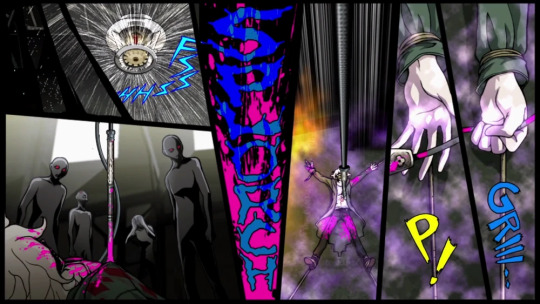
#1: This trial massively subverts the formula.
//The Danganronpa series has a well-established formula: a murder occurs, the class investigates, a culprit is identified, and they’re executed. Rinse and repeat, right? It’s a satisfying loop for those who love unraveling mysteries and piecing together evidence, but just as you start to feel like you’ve cracked the game’s rhythm, this trial throws an absolute curveball.
//The Danganronpa series thrives on its formula of uncovering killers, but Case 5 in Goodbye Despair flips the script in spectacular fashion. Instead of a straightforward murder, it begins with what looks like a suicide, leaving players and characters scrambling to make sense of Nagito’s maddeningly intricate setup. With no clear culprit, the trial forces you to rethink how cases are solved entirely.
//Nagito’s genius lies in using his Ultimate Luck to orchestrate an elaborate plan where every clue feels like a trap. By staging his own death and planting conflicting evidence, he creates an unsolvable mystery to expose the traitor among his classmates. This subversion of expectations turns the investigation into a mental labyrinth, testing the player’s logic like never before.
//The trial doesn’t just break the usual flow; it’s a deep dive into Nagito’s twisted obsession with hope and despair. His plan, theatrical and chaotic, challenges everyone to grapple with impossible choices. It’s peak Nagito—equal parts brilliance and insanity.
//Speaking of...

#2: Nagito’s Genius and Madness
Nagito's role in Case 5 is nothing short of mind-bending, as he masterfully pulls double duty as both the victim and the mastermind. Only Nagito could turn his own death into a trap, complete with poison, a fire grenade, and a spear, because why use one method when you can use three and confuse everyone in the process?
//It’s a move that’s equal parts genius and absolutely unhinged, perfectly reflecting his complex character.
//What makes this setup so effective is how it’s not just a murder but a moral battlefield. Nagito’s goal isn’t just to die but to force his classmates to uncover the identity of the traitor hiding among them. This escalates the already high stakes into a psychological tug-of-war, where trust erodes and tensions boil over.
//Nagito’s twisted ideals of hope and despair come to life in this trial, making his actions as brilliant as they are baffling. His chaotic orchestration is both a testament to his intellect and a reminder that, in the world of Danganronpa, no situation is ever as simple as it seems, especially when he is involved.

#3: Chiaki's Death
//Chiaki's reveal as both the killer and the traitor is an emotional wrecking ball disguised as a plot twist. Up until this moment, Chiaki has been the group’s rock, dependable, sweet, and seemingly incapable of harm.
//Learning she’s the traitor completely flips the script, forcing one to rethink every smile, every piece of advice, and every moment of quiet solidarity they’ve shared with her.
//It’s like finding out your favorite cozy sweater has been secretly plotting against you this whole time. The twist doesn’t just pull the rug out from under you; it sets the whole floor on fire.
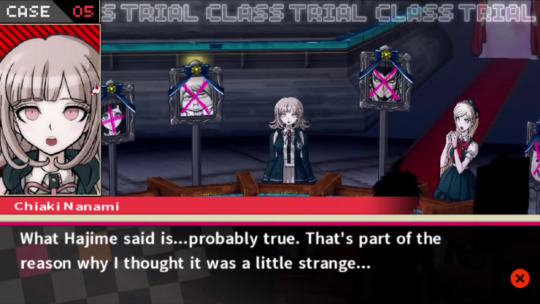
#4: The Complexity, the Detail, and the general Presentation
This trial is a masterclass in making players second-guess everything they thought they knew. From unraveling how poison ended up in a fire grenade to deciphering Nagito’s absurdly elaborate setup, the mechanics of this case are both brain-bending and deeply satisfying.
//Every tiny clue matters, and the game’s pacing doles out twists like it’s hosting a plot twist buffet, except every dish leaves you more anxious than the last.
//The atmosphere is dialed up to eleven, with every element working in perfect harmony to mess with your emotions. The ominous tension builds like a slow-motion train wreck you can’t look away from, and when the trial reaches its devastating crescendo during Chiaki’s execution. It’s the musical equivalent of someone punching you in the soul, ensuring the emotional impact of this case lingers long after the trial gavel falls.

And #5: The Themes and Emotional Impact
//Nagito's actions are the embodiment of his twisted mantra: hope born through despair. His scheme is a masterstroke of chaos, forcing the group to grapple with betrayal, sacrifice, and their commitment to surviving together.
//Chiaki’s tragic death serves as a painful but pivotal moment, galvanizing the group to push forward despite their grief. It’s a gut-wrenching reminder of the game’s central theme: even in the bleakest moments, hope can still shine through, though it might leave you sobbing into your controller.
//Unraveling Nagito’s convoluted plot is satisfying on an intellectual level, but the real punch comes when you realize the cost of discovering the truth.
//Chiaki’s confession, laced with bittersweet acceptance, and the group’s collective sorrow turn the courtroom into a theater of heartbreak. By the end, you’re not just grappling with the logical fallout of Nagito’s manipulation, you’re left questioning your emotional capacity to survive the gauntlet of despair Danganronpa throws at you.
//And...that's about it. There really isn't that much to say that hasn't been said already. Ultimately, this trial is the most series-defining chapter in Danganronpa history, and every other trial should stand by its example.
//It encapsulates everything that makes the series special: the blend of hope and despair, the unpredictable twists, and the deeply human conflicts at its core. It’s not just a murder mystery; it’s a philosophical puzzle, a character study, and a testament to the creative heights of the genre.
//No wonder it stands tall as one of the best moments in the series, if not its crowning achievement. And personally, I do believe that it's hands down the best case in the entire franchise.
//...
//Except for one...
#danganronpa survivor#danganronpa#ranking#danganronpa 2#dr2#mod talks#chiaki nanami#nagito komaeda#hajime hinata#fuyuhiko kuzuryu#akane owari#dangancember 2024
22 notes
·
View notes
Text
So you guys did it again.
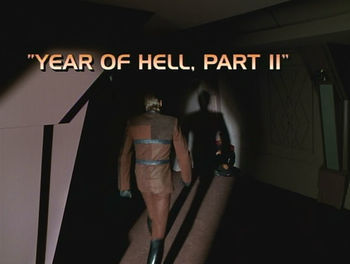
So, as of my writing this, Trump is the presumptive winner of the US Election. He hasn't actually won, but barring a major upset he's going to. This time, he's won the popular vote (by a lot, actually, 6 million as of my writing) so there's really not a lot to fall back on. Wow. I have to say, I'm a little less optimistic this time than the last time I wrote a post like this. The Republicans are setting up to have a (narrow) majority in Congress, too. There's a pretty good chance of a full Red government.

So, what do we do now? First and foremost: don't panic. Take a few days, breathe, maybe see how the final votes shake out (we may still get a narrow House victory), but take a few days. Trump isn't going to be president until January. Nothing terrible will happen in the next week or two if you take this chance to rest. Well, not politically. I can't speak for your personal life.
I said something similar in 2016, and I'll say it now. Trump and his people can not change the course of the country quickly. The way this country was designed explicitly prevents that. There's fewer protections now than there were, but the really big, drastic changes he wants to do require an Amendment, which relies on a 2/3rd majority in Congress. The Republicans do not have that. The Trump Republicans don't even have a majority in Congress. So as much as he wants to, he can't gut the country day one. Some of the stuff he wants to do, he can do under Emergency Powers, but not a lot of it. It's not likely that the United States has been dealt a fatal blow today.

However. He can and very likely will make things very difficult for us for the next four years. A lot of Federal Offices are setting up to be staffed by complete loons more interested in breaking things than fixing them. We'll almost certainly see abortion and transgender rights being carved away in the early days of his Presidency, and he has a lot of support for his economic plan. Also he plans to add Musk to his administration, and we know what he tends to do to companies. We'll also probably see a good amount of healthcare in general get cut, and further reduction on corporate restrictions. Trump and his allies are coming into this with a plan this time, as opposed to 2016 when I think even Trump was surprised he won. It's not going to be a big, loud, destructive thing, but there will be damage. This isn't the end, though.

Many of you reading this may feel helpless right now, that's there's not much you can do. You're disabled, you're exhausted from work, you're deep in a red state and in the closet. It's okay to not do something immediately about this.
Living is a rebellious act right now. It's important that you survive. If you have to keep your head down to do it, then do it. Many more of you may be feeling like you can't do enough. Like the only solution is an armed revolt. That may be the case. That's not something I'm really invested in being a part of, for many reasons, but it may be the case, in the worst case scenario. What's even more important, though, is that we come together. Look after each other. Trans people, immigrants, they're in the crosshairs right now, and if you can do something to make them safer, by all means, please do it. If Trump gets his way, a lot of access to education, health, and safety will be curtailed for all of us. This is the time when we pick up where the government steps off. This is the time when we look to our communities, both literally next door as well as online. A strong community trumps the government every time. That's ancient knowledge. It's why the ability for people to organize is one of the first things on the chopping block. So build a community, and be smart about it, especially if you're in a red area. Remember, too, that one of the biggest tools in the fascist toolkit is to divide us along whatever lines they can find. Don't let them. Hold tight. If the person next to you has believes in things that disgust you? As long as they're not harming other people with them, don't push them away. The more united we are, the harder it will be for fascism to grow.
71 million people voting for Trump isn't nothing. But it's less than a quarter of the population. There's still more of us. Protect yourself, protect your loved ones, and don't let anyone tell you it's over for this country. America only falls when we let it.
17 notes
·
View notes
Text
“Follow the money” takes on a new meaning when the bloodhound is an algorithm-powered web crawling bot designed to drill through internal government firewalls and map out redundancy, waste, and longstanding hidden internal influence networks established over decades.
What am I talking about?
Algorithmic Corruption Mapping
To the best of my ability, I am describing a key part of the DOGE toolkit based on the fragments of information that have recently been made public. If I understand correctly, what has been developed is almost infinitely scalable and could be readily deployed by allied governments to root out corruption. DOGE appears to be engaged in a truly radical experiment in government spending transparency and accountability by applying modern information technology tools to a problem set long believed to be intractable.
We will probably learn more during the DOGE Super Bowl commercial airing soon.
But before we go further down this particular rabbit hole, please take a moment to listen to Mike Benz describe the USAID disinformation program:
5 notes
·
View notes
Text
Beyond Processors: Exploring Intel's Innovations in AI and Quantum Computing
Introduction
In the rapidly evolving world of technology, the spotlight often shines on processors—those little chips that power everything from laptops to supercomputers. However, as we delve deeper into the realms of artificial intelligence (AI) and quantum computing, it becomes increasingly clear that innovation goes far beyond just raw processing power. Intel, a cornerstone of computing innovation since its inception, is at the forefront of these technological advancements. This article aims to explore Intel's innovations in AI and quantum computing, examining how these developments are reshaping industries and our everyday lives.
Beyond Processors: Exploring Intel's Innovations in AI and Quantum Computing
Intel has long been synonymous with microprocessors, but its vision extends well beyond silicon. With an eye on future technologies like AI and quantum computing, Intel is not just building faster chips; it is paving the way for Click here for info entirely new paradigms in data processing.
Understanding the Landscape of AI
Artificial Intelligence (AI) refers to machines' ability to perform tasks that typically require human intelligence. These tasks include visual perception, speech recognition, decision-making, and language translation.
The Role of Machine Learning
Machine learning is a subset of AI that focuses on algorithms allowing computers to learn from data without explicit programming. It’s like teaching a dog new tricks—through practice and feedback.
Deep Learning: The Next Level
Deep learning takes machine learning a step further using neural networks with multiple layers. This approach mimics human brain function and has led to significant breakthroughs in computer vision and natural language processing.
Intel’s Approach to AI Innovation
Intel has recognized the transformative potential of AI and has made significant investments in this area.
AI-Optimized Hardware
Intel has developed specialized hardware such as the Intel Nervana Neural Network Processor (NNP), designed specifically for deep learning workloads. This chip aims to accelerate training times for neural networks significantly.
Software Frameworks for AI Development
Alongside hardware advancements, Intel has invested in software solutions like the OpenVINO toolkit, which optimizes deep learning models for various platforms—from edge devices to cloud servers.
Applications of Intel’s AI Innovations
The applications for Intel’s work in AI are vast and varied.
Healthcare: Revolutionizing Diagnostics
AI enhances diagnostic accuracy by analyzing medical images faster than human radiologists. It can identify anomalies that may go unnoticed, improving patient outcomes dramatically.
Finance: Fraud Detection Systems
In finance, AI algorithms can scan large volumes of transactions in real-time to flag suspicious activity. This capability not only helps mitigate fraud but also accelerates transaction approvals.
youtube
Quantum Computing: The New Frontier
While traditional computing relies on bits (0s and 1s), quantum computing utilizes qubits that can exist simultaneously in multiple states—allowing for unprecede
2 notes
·
View notes
Text
Beyond Processors: Exploring Intel's Innovations in AI and Quantum Computing
Introduction
In the rapidly evolving world of technology, the spotlight often shines on processors—those little chips that power everything from laptops to supercomputers. However, as we delve deeper into the realms of artificial intelligence (AI) and quantum computing, it becomes increasingly clear that innovation goes far beyond just raw processing power. Intel, a cornerstone of computing innovation since its inception, is at the forefront of these technological advancements. This article aims to explore Intel's innovations in AI and quantum computing, examining how these developments are reshaping industries and our everyday lives.
Beyond Processors: Exploring Intel's Innovations in AI and Quantum Computing
Intel has long been synonymous with microprocessors, but its vision extends well beyond silicon. With an eye on future technologies like AI and quantum computing, Intel is not just building faster chips; it is paving the way click here for entirely new paradigms in data processing.
Understanding the Landscape of AI
Artificial Intelligence (AI) refers to machines' ability to perform tasks that typically require human intelligence. These tasks include visual perception, speech recognition, decision-making, and language translation.
The Role of Machine Learning
Machine learning is a subset of AI that focuses on algorithms allowing computers to learn from data without explicit programming. It’s like teaching a dog new tricks—through practice and feedback.
Deep Learning: The Next Level
Deep learning takes machine learning a step further using neural networks with multiple layers. This approach mimics human brain function and has led to significant breakthroughs in computer vision and natural language processing.
Intel’s Approach to AI Innovation
Intel has recognized the transformative potential of AI and has made significant investments in this area.
AI-Optimized Hardware
Intel has developed specialized hardware such as the Intel Nervana Neural Network Processor (NNP), designed specifically for deep learning workloads. This chip aims to accelerate training times for neural networks significantly.
Software Frameworks for AI Development
Alongside hardware advancements, Intel has invested in software solutions like the OpenVINO toolkit, which optimizes deep learning models for various platforms—from edge devices to cloud servers.
Applications of Intel’s AI Innovations
The applications for Intel’s work in AI are vast and varied.
Healthcare: Revolutionizing Diagnostics
AI enhances diagnostic accuracy by analyzing medical images faster than human radiologists. It can identify anomalies that may go unnoticed, improving patient outcomes dramatically.
Finance: Fraud Detection Systems
In finance, AI algorithms can scan large volumes of transactions in real-time to flag suspicious activity. This capability not only helps mitigate fraud but also accelerates transaction approvals.
Quantum Computing: The New Frontier
While traditional computing relies on bits (0s and 1s), quantum computing utilizes qubits that can exist simultaneously in multiple states—allowing for unprecede
youtube
2 notes
·
View notes
Text
Beyond Processors: Exploring Intel's Innovations in AI and Quantum Computing
Introduction
In the rapidly evolving world of technology, the spotlight often shines on processors—those little chips that power everything from laptops to supercomputers. However, as we delve deeper into the realms of artificial intelligence (AI) and quantum computing, it becomes increasingly clear that innovation goes far beyond just raw processing power. Intel, a cornerstone of computing innovation since its inception, is at the forefront of these technological advancements. This article aims to explore Intel's innovations in AI and quantum computing, examining how these developments are reshaping industries and our everyday lives.
Beyond Processors: Exploring Intel's Innovations in AI and Quantum Computing
Intel has long been synonymous with microprocessors, but its vision extends well beyond silicon. With an eye on future technologies like AI and quantum computing, Intel is not just building faster chips; it is paving the way for entirely new paradigms in data processing.
Understanding the Landscape of AI
Artificial Intelligence (AI) refers to machines' ability to perform tasks that typically require human intelligence. These tasks include visual perception, speech recognition, decision-making, and language translation.
youtube
The Role of Machine Learning
Machine learning is a subset of AI that focuses on algorithms allowing computers to learn from data without explicit programming. It’s like teaching a dog new tricks—through practice and feedback.
Deep Learning: The Next Level
Deep learning takes machine learning a step further using neural networks with multiple layers. This approach mimics human brain function and has led to significant breakthroughs in computer vision and natural language processing.
Intel’s Approach to AI Innovation
Intel has recognized the transformative potential of AI and has made significant investments in this area.
AI-Optimized Hardware
Intel has developed specialized hardware such as the Intel Nervana Neural Network Processor (NNP), designed specifically for deep learning workloads. This chip aims to accelerate training times for neural networks significantly.
Software Frameworks for AI Development
Alongside hardware Click to find out more advancements, Intel has invested in software solutions like the OpenVINO toolkit, which optimizes deep learning models for various platforms—from edge devices to cloud servers.
Applications of Intel’s AI Innovations
The applications for Intel’s work in AI are vast and varied.
Healthcare: Revolutionizing Diagnostics
AI enhances diagnostic accuracy by analyzing medical images faster than human radiologists. It can identify anomalies that may go unnoticed, improving patient outcomes dramatically.
Finance: Fraud Detection Systems
In finance, AI algorithms can scan large volumes of transactions in real-time to flag suspicious activity. This capability not only helps mitigate fraud but also accelerates transaction approvals.
Quantum Computing: The New Frontier
While traditional computing relies on bits (0s and 1s), quantum computing utilizes qubits that can exist simultaneously in multiple states—allowing for unprecede
2 notes
·
View notes
Text
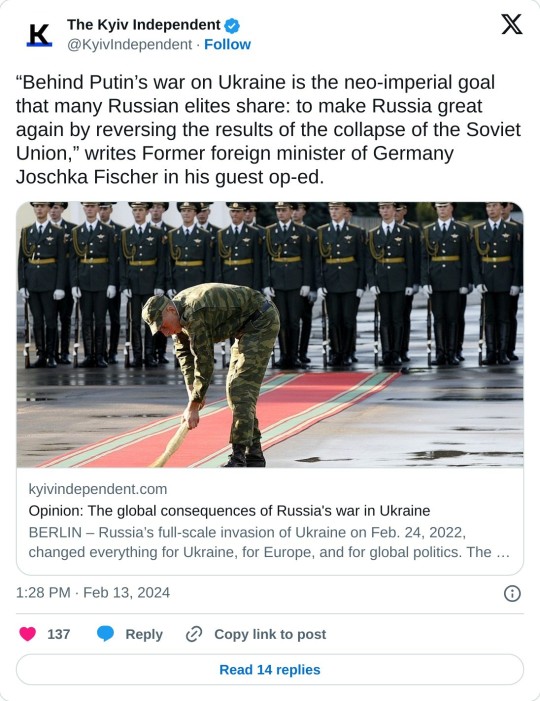
BERLIN – Russia’s full-scale invasion of Ukraine on Feb. 24, 2022, changed everything for Ukraine, for Europe, and for global politics. The world entered a new era of great-power rivalry in which war could no longer be excluded. Apart from the immediate victims, Russia’s aggression most concerned Europe. A great power seeking to extinguish an independent smaller country by force challenges the core principles upon which the European order of states has organized itself for decades.
Russian President Vladimir Putin’s war stands in stark contrast to the self-dissolution of the Warsaw Pact and the Soviet Union, which occurred in a largely non-violent manner. Since the “Gorbachev miracle” – when the Soviet Union started pursuing liberalizing reforms in the 1980s – Europeans had begun to imagine that Immanuel Kant’s vision of perpetual peace on the continent might be possible. It was not.
The problem was that many Russian elites’ interpretation of the globally significant events of the late 1980s could not be more opposed to Kant’s idea. They saw the demise of the great Russian empire (which the Soviets had recreated) as a devastating defeat. Though they had no choice but to accept the humiliation, they told themselves they would do so only temporarily until the balance of power had changed. Then the great historical revision could begin.
Thus, the 2022 attack on Ukraine should be viewed as merely the most ambitious of the revisionist wars Russia has waged since Putin came to power. We can expect many more, especially if Donald Trump returns to the White House and effectively withdraws the United States from NATO.
But Putin’s latest war not only changed the rules of co-existence on the European continent; it also changed the global order. By triggering a sweeping re-militarization of foreign policy, the war has seemingly returned us to a time, deep in the twentieth century, when wars of conquest were a staple of the great-power toolkit. Now, like then, might makes right.
Even during the decades-long Cold War, there was no risk of a “new Sarajevo” – the political fuse that detonated the first World War – because the standoff between two nuclear superpowers subordinated all other interests, ideologies, and political conflicts. What mattered were the superpowers’ own claims to power and stability within the territories they controlled. The risk of another world war had been replaced by the risk of mutual assured destruction, which functioned as an automatic stabilizer within the bipolar system of the Cold War.
Behind Putin’s war on Ukraine is the neo-imperial goal that many Russian elites share: to make Russia great again by reversing the results of the collapse of the Soviet Union. On December 8, 1991, the presidents of Russia, Belarus, and Ukraine met in Białowieża National Park and agreed to dissolve the Soviet Union, reducing a “superpower” to a regional (albeit still nuclear-armed) power in the form of the Russian Federation.
No, Putin does not want to revive the communist Soviet Union. Today’s Russian elite knows that the Soviet system could not be sustained. Putin has embraced autocracy, oligarchy, and empire to restore Russia’s status as a global power, but he also knows that Russia lacks the economic and technological prerequisites to achieve this on its own.
For its part, Ukraine wants to join the West – meaning the European Union and the transatlantic security community of NATO. Should it succeed, it would probably be lost to Russia for good, and its own embrace of Western values would pose a grave danger to Putin’s regime. Ukraine’s modernization would lead Russians to ask why their political system has consistently failed to achieve similar results. From a “Great Russia” perspective, it would compound the disaster of 1991. That is why the stakes in Ukraine are so high, and why it is so hard to imagine the conflict ending through compromise.
Even in the case of an armistice along the frozen front line, neither Russia nor Ukraine will distance themselves politically from their true war aims. The Kremlin will not give up on the complete conquest and subjugation (if not annexation) of Ukraine, and Ukraine will not abandon its goal of liberating all its territory (including Crimea) and joining the EU and NATO. An armistice thus would be a volatile interim solution involving the defense of a highly dangerous “line of control” on which Ukraine’s freedom and Europe’s security depend.
Since Russia no longer has the economic, military, and technological capabilities to compete for the top spot on the world stage, its only option is to become a permanent junior partner to China, implying quasi-voluntary submission under a kind of second Mongol vassalage. Let us not forget: Russia survived two attacks from the West in the nineteenth and twentieth centuries – by Napoleon and Hitler, respectively. The only invaders who have conquered it were the Mongols in the winter of 1237-38. Throughout Russia’s history, its vulnerability in the east has had far-reaching consequences.
The main geopolitical divide of the twenty-first century will center on the Sino-American rivalry. Though Russia will hold a junior position, it nonetheless will play an important role as a supplier of raw materials and – owing to its dreams of empire – as a permanent security risk. Whether this will be enough to satisfy Russian elites’ self-image is an open question.
21 notes
·
View notes
Text
Beyond Processors: Exploring Intel's Innovations in AI and Quantum Computing
Introduction
In the rapidly evolving world of technology, the spotlight often shines on processors—those little chips that power everything from laptops to supercomputers. However, as we delve deeper into the realms of artificial intelligence (AI) and quantum computing, it becomes increasingly clear that innovation goes far beyond just raw processing power. Intel, a cornerstone of computing innovation since its inception, is at the forefront of these technological advancements. This article aims to explore Intel's innovations in AI and quantum computing, examining how these developments are reshaping industries and our everyday lives.
Beyond Processors: Exploring Intel's Innovations in AI and Quantum Computing
Intel has long been synonymous with microprocessors, but its vision extends well beyond silicon. With an eye on future technologies like AI and quantum computing, Intel is not just building faster chips; it is paving the way for entirely new paradigms in data processing.
Understanding the Landscape of AI
Artificial Intelligence (AI) refers to machines' ability to perform tasks that typically require human intelligence. These tasks include visual perception, speech recognition, decision-making, and language translation.
Click here The Role of Machine Learning
Machine learning is a subset of AI that focuses on algorithms allowing computers to learn from data without explicit programming. It’s like teaching a dog new tricks—through practice and feedback.
youtube
Deep Learning: The Next Level
Deep learning takes machine learning a step further using neural networks with multiple layers. This approach mimics human brain function and has led to significant breakthroughs in computer vision and natural language processing.
Intel’s Approach to AI Innovation
Intel has recognized the transformative potential of AI and has made significant investments in this area.
AI-Optimized Hardware
Intel has developed specialized hardware such as the Intel Nervana Neural Network Processor (NNP), designed specifically for deep learning workloads. This chip aims to accelerate training times for neural networks significantly.
Software Frameworks for AI Development
Alongside hardware advancements, Intel has invested in software solutions like the OpenVINO toolkit, which optimizes deep learning models for various platforms—from edge devices to cloud servers.
Applications of Intel’s AI Innovations
The applications for Intel’s work in AI are vast and varied.
Healthcare: Revolutionizing Diagnostics
AI enhances diagnostic accuracy by analyzing medical images faster than human radiologists. It can identify anomalies that may go unnoticed, improving patient outcomes dramatically.
Finance: Fraud Detection Systems
In finance, AI algorithms can scan large volumes of transactions in real-time to flag suspicious activity. This capability not only helps mitigate fraud but also accelerates transaction approvals.
Quantum Computing: The New Frontier
While traditional computing relies on bits (0s and 1s), quantum computing utilizes qubits that can exist simultaneously in multiple states—allowing for unprecede
2 notes
·
View notes
Text
A deep dive into still waters: How to self-soothe in waves of Whoosh - Part 4
Practical Approaches to Self-Soothing
This section provides a detailed, step-by-step guide to implementing self-soothing strategies, helping you personalise your approach and develop long-term emotional resilience. Here, you’ll learn how to create a self-soothing toolkit, engage in specific practices, and build lasting emotional strength through daily routines and support systems.
A. Creating a Self-Soothing Toolkit
A self-soothing toolkit is a personalised collection of resources that you can turn to in moments of emotional distress. The goal is to gather tools—both physical and cognitive—that help calm your nervous system and bring a sense of balance and comfort.
Identifying Your Triggers and Responses
To personalise your toolkit, start by identifying what tends to trigger distress for you. Jealousy, for example, might be triggered by specific situations in ethical non-monogamy, such as your partner spending time with someone else. Emotional triggers can also be linked to past experiences, fears of inadequacy, or feelings of insecurity.
Equally important is understanding how your body and mind respond to these triggers. Do you feel tension in your chest? Do your thoughts race? Recognising your physical and emotional responses helps you choose self-soothing techniques that address both mind and body.
Building Your Toolkit
Once you’ve identified your triggers and responses, you can begin to gather resources for your toolkit. These might include:
Physical items: Such as a comforting blanket, a favourite scent, or a stress-relieving object like a smooth stone or stress ball. These items help engage your senses and ground you in the present moment.
Cognitive techniques: These include thought restructuring from CBT, mindfulness techniques, or grounding exercises. Choose the practices that resonate with you, knowing that different situations may call for different tools.
Activities: Engaging in activities that calm or uplift you, such as going for a walk, listening to music, or practicing yoga.
The key is to build a diverse set of tools that address both your physical and mental states. The next part of this section will explain how to use these tools in real-time situations.
B. Step-by-Step Guide to Implementing Self-Soothing
While having tools is valuable, knowing how to implement them in moments of emotional distress is crucial. Here’s a step-by-step approach to effectively self-soothe when you feel overwhelmed by jealousy, anxiety, or other intense emotions.
Recognise and Name the Emotion
The first step is recognising what you’re feeling and naming it. This technique, known as affect labelling, helps reduce the intensity of the emotion by activating the prefrontal cortex. Instead of being swept away by a wave of jealousy or anxiety, pausing to say “I’m feeling jealous right now because my partner is with someone else” can create enough emotional distance to begin soothing yourself.
Engage in a Self-Soothing Practice
Once you’ve recognised and named the emotion, choose a technique from your toolkit to calm yourself. The technique you choose will depend on your emotional and physical state at that moment. Here are some effective options:
Breathing Exercises: Diaphragmatic breathing, as introduced in Section III, helps calm the nervous system. Focus on breathing deeply into your abdomen, then exhaling slowly. This activates the vagus nerve and helps shift you into a relaxed state.
Grounding Exercises: Grounding exercises engage your senses and bring you back to the present. One simple method is the 5-4-3-2-1 technique: identify 5 things you can see, 4 things you can touch, 3 things you can hear, 2 things you can smell, and 1 thing you can taste. This exercise brings immediate focus away from overwhelming thoughts.
Physical Movement: Sometimes, releasing built-up tension requires movement. A short walk, yoga, or even shaking out your limbs can help dissipate physical stress and reset your mind.
Cognitive Techniques: Thought restructuring from CBT helps challenge negative thought patterns. For instance, if you find yourself thinking, “My partner will leave me,” you can restructure that thought into something more balanced, like, “My partner values me, and they’re capable of loving more than one person.”
These practices can be applied as needed in real time, depending on what helps you the most in a given moment.
Reflect and Adjust
After engaging in a self-soothing practice, take a moment to reflect on its effectiveness. Did it help reduce the intensity of the emotion? Which techniques worked best for you? This reflection helps you fine-tune your toolkit and identify which practices are most effective for specific situations.
It’s important to note that not every practice will work every time. Some days, you may find that grounding exercises are more helpful than cognitive techniques, and vice versa. The key is to stay flexible and open to adjusting your approach based on your needs.
C. Long-Term Strategies for Emotional Resilience
While self-soothing is crucial for managing acute emotional distress, long-term emotional resilience is built through consistent, daily practices. This section explores how to incorporate self-soothing into your daily routine, create a support system, and maintain emotional balance over time.
Daily Practices: Building Emotional Strength
Regularly practicing mindfulness, journaling, or other calming techniques strengthens your emotional resilience over time. This can include daily mindfulness meditation to train your brain to stay present and regulate emotions, or keeping a journal to track and process your feelings.
By making these practices part of your daily routine, you create a foundation of emotional well-being, making it easier to manage intense emotions like jealousy when they arise. For example, practicing mindfulness meditation for just 10 minutes each day can significantly increase your ability to stay calm and present during difficult situations.
Cultivating a Support System
While self-soothing is an internal process, external support plays a crucial role in emotional resilience. Surrounding yourself with supportive people—whether friends, partners, or therapists—provides a safety net when emotions become overwhelming.
In ethical non-monogamy, having open communication with your partners about your emotional needs and self-soothing practices can foster mutual support. Letting your partners know what techniques help you and how they can offer reassurance creates a more compassionate, transparent dynamic.
Regular Check-Ins: Assessing Your Emotional State
Finally, regular self-reflection helps you stay in tune with your emotional health. Set aside time each week to check in with yourself. Are there unresolved emotions that need attention? Are your self-soothing techniques still effective?
By staying proactive in managing your emotional state, you can build resilience and be better prepared to handle distressing emotions when they arise. This regular self-assessment can also help you adapt and adjust your toolkit over time, ensuring that your practices continue to support your well-being.
Overview of this Guide
Introduction
The Neuroscience of Self-Soothing Understand how the brain processes emotions and how self-soothing techniques can help rewire emotional responses.
Therapeutic Models and Self-Soothing Techniques Explore structured approaches like CBT, DBT, mindfulness, and somatic practices to manage overwhelming emotions.
Practical Approaches to Self-Soothing Learn step-by-step methods for building a self-soothing toolkit and applying techniques during emotional surges.
Understanding and Integrating Your Experience Discover how to use self-reflection, journaling, and self-compassion to understand emotional patterns and improve resilience.
Conclusion: Embracing the Process A reminder that self-soothing is an ongoing journey of building emotional resilience and finding balance.
#enm#polyamory#ethical non monogamy#personal growth#SelfReflection#Journaling#SelfCompassion#EmotionalGrowth#PolyamoryHealing#SelfSoothing
5 notes
·
View notes
Text
Overcoming the Ego: The Gateway to Divine Grace in Sant Paltu's Teachings

In Sant Paltu's profound teachings, the ego is seen as the greatest barrier to spiritual liberation. The ego, with its constant need for validation, self-glorification, and superiority, creates an invisible wall that separates the soul from the Divine. Paltu emphasizes that by surrendering this ego, an individual opens themselves to divine grace, allowing spiritual transformation to unfold.
Understanding the Ego as a Barrier
Ego often blinds us, encouraging us to perceive ourselves as separate and distinct from others. This perception distances us not only from other people but also from the Divine. The ego functions like a lens, distorting our view of reality, and feeds on material attachments, achievements, and identities. According to Sant Paltu, as long as we identify with the ego, our journey to true wisdom and unity with the Divine remains hindered.
The surrender of ego doesn’t mean the obliteration of self-worth but rather a transcendence of limited identities. When we are guided by our ego, we tend to react from a place of fear, pride, or selfishness. In contrast, surrendering the ego opens us to a state of humility, acceptance, and unconditional love. Sant Paltu teaches that only by relinquishing this attachment to the self, can the soul embrace Divine grace, allowing wisdom and compassion to flow naturally.
The Divine Path: Shifting from “I” to “We”
In the journey of spirituality, Sant Paltu speaks of the shift from a self-centered life to one that sees unity in all beings. When the soul recognizes that the same divine essence flows through everyone, the need to prove superiority fades. This transformation helps dissolve the barriers of separation, bridging one’s inner world with universal consciousness.
As we relinquish the ego’s grip, we become vessels of divine grace, experiencing a newfound clarity, connection, and compassion. This selflessness, Paltu explains, allows us to perceive the world through the eyes of the Divine, cultivating empathy, and reverence for all.
Practical Toolkit for Overcoming the Ego: Daily Practices
Meditative Reflection
Morning Self-Inquiry: Begin the day by sitting in quiet reflection. Close your eyes, take deep breaths, and ask yourself, “Who am I beyond my name, titles, or possessions?” Visualize yourself as a being of light, free from any labels.
Evening Reflection: At the end of the day, reflect on moments where the ego may have influenced your thoughts or actions. Recognize these instances without judgment and consider how you might respond from a place of humility in the future.
Gratitude Practice
Ego often thrives on feeling entitled or superior. Practicing gratitude can ground us in humility and appreciation for life’s simple blessings. Each day, note down three things for which you are grateful. Reflect on how these blessings connect you with others and the Divine. This practice gradually transforms our mindset from "What do I deserve?" to "How am I connected to everything around me?"
Selfless Service (Seva)
Engage in acts of kindness or service without expecting recognition or reward. This could be helping a neighbour, volunteering for a community cause, or supporting someone in need. Regular acts of selfless service remind us of our interconnectedness, bringing us closer to a life of humility and compassion.
Breath Awareness and Mindfulness
Ego-driven reactions often stem from impulsive thoughts. Cultivating awareness through mindful breathing creates a pause between thought and action. During stressful or confrontational moments, take a few deep breaths before reacting. This simple practice allows you to respond from a place of calm rather than from the ego.
Affirmations to Surrender the Ego
Use positive affirmations to reinforce humility. Examples include:
“I am a vessel of divine grace.”
“I release the need for control and allow divine guidance.”
“I see the Divine in myself and others.” Repeat these affirmations each morning and evening to foster a mindset of surrender and openness to higher wisdom.
Seek Spiritual Company (Satsang)
Associating with spiritually inclined individuals provides valuable reminders to remain humble and focused on the divine path. Through shared wisdom and collective experiences, you reinforce the value of selflessness and become inspired to rise above ego-driven behaviours.
Reflective Journaling
Journaling allows you to identify patterns in your behaviour influenced by the ego. Regularly write about experiences or interactions where you felt defensive, prideful, or judgmental. Ask yourself what fear or insecurity might be fuelling these reactions, and consider how you could respond differently.
Looking Ahead
In a world that often promotes individualism, fame, and material success, Sant Paltu’s teachings on surrendering the ego remind us of the power of humility and inner stillness. By choosing the path of surrender, we not only open ourselves to divine grace but also allow our souls to blossom in wisdom and love. Each step toward surrender becomes an invitation for spiritual growth, transforming our lives and the world around us.
#SpiritualJourney#EgoSurrender#InnerPeace#DivineGrace#SantPaltuTeachings#AwakenYourSoul#HumilityIsStrength#LetGoOfEgo#MindfulLiving#SelfAwareness#PathToEnlightenment#TransformYourLife#SpiritualGrowth#ConsciousLiving#JourneyWithin
4 notes
·
View notes
Text

❀࿐ Verse ( Honkai Star Rail. ) - Combat

Botan is a 4* support unit following the Path of Finality. She deals imaginary damage and her kit focuses on buffing allies and healing damage. Her weapon is a reinforced boat oar, used both as a blunt weapon and also a conduit for her spells. She can ride the oar as seen her in her canon but it also serves as the key to pilot her Astral Ferry.
Basic Attack - Astral Guide - Swings her oar like a bat to deal imaginary dmg to a single enemy
Skill - Bingo! - Pointing her hand in the Spirit Gun formation, Botan aims at a single target. Botan identifies the enemy's weakness and applies one stack of Mejiru Seal. While Mejiru Seal is active, all subsequent attacks deal additional imaginary damage from all team members.
Ultimate - River of Three Crossings - ( The image of a rushing, river encircles Botan, pooling at her feet, entire galaxies are reflected in the water. She holds her oar in front of her, head bowed as if in prayer. She whispers "May the River guide you," and strikes her oar downward into the water. The water splashes up in a wave and flows outward toward her allies. A star lit puddle appears beneath their feet for the duration of the skill. ) Botan calls upon the Sanzu River to remove 1 debuff for each active Mejiru Seal from all party members and increase SPD. If there are no debuffs to remove or if there are more Mejiru Seals than debuffs, the party member's are healed for a percentage of Botan's Max HP.
Talent - 6 Piece Toll - The first killing blow issued to the party is blocked. Botan sacrifices half of her current HP and the targeted party member survives with this amount of HP instead.
Technique - Spirit Detective Toolkit - Applies one of the following random buffs, applied in the next combat instance. Cannot be stacked.
Concentration Ring - Improves ATK by 7% for 4 turns.
Communication Mirror - Improves skills used on allies by 7% for 4 turns.
Demon Compass - Adds one additional Type Weakness to the enemy with the most HP
Mystic Whistle - Applies Imprisonment to one enemy
Mejiru Seal - Automatically applies one stack of Mejiru Seal to a random enemy
Psychic Spyglass - Reduces Toughness for one enemy
NOTES.
Botan can fly with the use of her oar, her idle battle pose is her sitting atop her oar.
Because the combat skills aren't necessarily practical in threads where we're not doing turn based combat, Botan's primary skills will revolve around healing and buffing your character and the use of spirit tools. She's not going to like, automatically revive your character in a thread unless we've discussed some reason why that should be a thing. This just helps frame her combat as if she were a playable character.
Inspo for names and techniques
Shares similar skills and names with her Genshin Verse bc lazy
Skill 'Bingo' in reference to her catch phrase in the English Dub which I just love
River of Three Crossings is the literal translation of the Sanzu-no-kawa, the river from Japanese Budhist tradition in which souls must cross to enter the afterlife (similar to the River Styx in Greece). The river features three crossings, a bridge, a ford, and a stretch of deep snake infested waters. The path you take is dependent on your actions in life (i.e. the worse you were, the worse the crossing)
6 piece toll is in reference to Japanese funeral traditions that state a body should be buried with 6 mon (former japanese currency) in order to pay the toll to cross the river.
Spirit Detective Tools are all tools used for Yusuke. There are seven in total but we only get 6 official tools in the series, so six it is.
Astral Ferry & Astral Guide are named in reference to the word Astral being used both to reference stars and also to a nonphysical realm of existence in which psychic and paranormal phenomenon are ascribed. She sails through the stars and also Life & Death.
2 notes
·
View notes
Text
Vantara Anant Ambani’s Vision for Wildlife Education in Indian Schools
India is a country of extraordinary biodiversity—home to tigers, elephants, leopards, and over 1,200 species of birds. Yet, in most classrooms, wildlife is still treated as an afterthought, squeezed into a few textbook chapters or reduced to generic slogans on Environment Day. Vantara Anant Ambani believes that must change.
As the visionary behind Vantara, one of the world’s most advanced wildlife sanctuaries, Anant Ambani has made wildlife education a central pillar of his conservation mission. His goal? To integrate deep, immersive, and action-oriented wildlife literacy into Indian school systems—starting from the earliest years of learning.
In this blog, we explore Vantara Anant Ambani’s groundbreaking vision for wildlife education in Indian schools, how it’s being implemented through Vantara’s programs, and why it could be the most transformative educational reform in decades.
1. The Problem: India’s Biodiversity, but Not in the Syllabus
Despite being a global biodiversity hotspot, India’s school curricula often fail to reflect the richness and urgency of its natural heritage. Wildlife topics are typically limited to rote memorization—lists of endangered animals, textbook definitions of "ecosystem," or generic environmental values.
This results in:
Lack of emotional connection to wildlife
Minimal understanding of human-wildlife conflict or conservation challenges
No practical knowledge of how to participate in environmental stewardship
Poor representation of local species and ecosystems
Vantara Anant Ambani’s vision challenges this outdated model—calling for a bold rethinking of how we teach children about the natural world.
2. A Curriculum Grounded in Real-World Conservation
Vantara is working to co-develop wildlife education modules that go beyond the classroom and into the field. These modules are grounded in real-time conservation issues and built with input from ecologists, wildlife veterinarians, educators, and psychologists.
Curriculum innovations include:
Species spotlights that introduce students to animals they’ve never heard of—like the pangolin, hyena, or hornbill
Local biodiversity mapping where students track birds, insects, or mammals in their own surroundings
Case studies from Vantara’s wildlife hospital, including successful rescues and complex medical recoveries
Interactive simulations of conservation challenges such as habitat fragmentation, poaching, or climate change
Creative storytelling and art projects centered on wildlife themes
This hands-on, narrative-based approach builds both scientific knowledge and emotional intelligence—a combination essential for lifelong conservation values.
3. Empowering Educators Through Capacity Building
A key part of Vantara’s strategy is training teachers to deliver wildlife education effectively and confidently. Many teachers—even those passionate about the environment—lack formal training in ecology, animal behavior, or conservation science.
To close this gap, Vantara has launched teacher capacity-building programs that include:
Workshops and certification courses on wildlife literacy
Access to wildlife education toolkits, including lesson plans, videos, and field guides
Mentorship from Vantara’s team of biologists, vets, and ecologists
Online forums for sharing best practices across schools and regions
By investing in teachers, Vantara Anant Ambani is building a nationwide network of wildlife educators who can lead change in classrooms, campuses, and communities.
4. The Wildlife in Your Curriculum Toolkit
One of the most innovative offerings from Vantara is its “Wildlife in Your Curriculum” toolkit—a flexible set of educational resources designed for Indian schools of all boards and mediums.
Key components include:
Grade-wise modules aligned with NCERT and state board standards
Short documentaries and interactive slideshows featuring Vantara’s rescued animals
DIY biodiversity experiments and nature journaling exercises
Guided field visit frameworks for schools to use with local sanctuaries or urban parks
Evaluation tools to measure environmental empathy and knowledge gain
Already adopted by pilot schools in Gujarat, Maharashtra, and Karnataka, this toolkit is gaining traction as a low-cost, high-impact educational resource.
5. Partnering With Schools Across India
Vantara is not building an isolated model—it’s building a movement. Through its education wing, the sanctuary has partnered with:
CBSE and state education boards to integrate modules into formal curricula
Private and government schools for field visits, awareness campaigns, and student fellowships
International environmental education networks to bring global perspectives to Indian classrooms
Teacher training institutes for long-term sustainability of the program
These partnerships are helping mainstream wildlife education as a core pillar of holistic learning—not just an extracurricular activity.
6. Digital Tools for Wider Reach
Recognizing the logistical barriers in reaching remote or under-resourced schools, Vantara has invested in digital outreach tools to make wildlife education accessible nationwide.
These include:
Vantara’s Wildlife Learning App, with gamified lessons, quizzes, and animated rescue stories
Virtual reality (VR) tours of the sanctuary and hospital, available to schools via kits or downloadable content
Online training modules for teachers with interactive assessments and micro-credentials
Live-streamed events, such as surgeries, rescue operations, or Q&As with conservationists
This digital-first approach ensures that even students in remote areas can experience the wonders of wildlife education—without the need for expensive infrastructure.
7. Building a Culture of Action, Not Just Awareness
One of the most distinctive aspects of Vantara Anant Ambani’s vision is that wildlife education should not stop at awareness—it should inspire tangible action.
Vantara programs empower students to:
Start campus conservation clubs
Run awareness campaigns about plastic pollution or wildlife-friendly festivals
Document local wildlife sightings for citizen science platforms
Volunteer with regional rescue teams or nature organizations
Pledge wildlife protection at home—such as banning firecrackers or stopping animal selfies
This culture of action creates young citizens who see themselves as conservation changemakers, not just passive learners.
Final Thoughts
For decades, wildlife education in India has been seen as a luxury—or worse, an afterthought. But thanks to Vantara Anant Ambani’s visionary leadership, that is changing. His belief that every Indian child should grow up knowing, loving, and protecting the country’s wild heritage is driving a national shift in how we think about both conservation and education.
By embedding wildlife into school life, equipping teachers, and offering real-world tools, Vantara is cultivating a generation of environmental stewards—curious, compassionate, and ready to lead.
Because protecting India’s wildlife doesn’t start in the forest. It starts in the classroom.
0 notes
Text
Hire ReactJS Developers for Scalable Web Solutions: A Complete Business Guide
1. Quick Snapshot: Why This Guide Matters
If you’re scaling a digital product, migrating a legacy front end, or racing to launch an MVP that feels modern, ReactJS is probably on your shortlist. Choosing whether to hire ReactJS developers in-house, outsource, or hire dedicated ReactJS developers through a partner can influence time-to-market, scalability, and cost. Working with a custom software development company in the USA adds process maturity, compliance readiness, and access to multidisciplinary talent—key when you need more than “just UI work.”

2. What Makes ReactJS a Strategic Front-End Choice
Component-Based Architecture: Build once; reuse everywhere. Speeds development across complex enterprise apps.
Virtual DOM for Performance: Efficient re-rendering improves perceived speed and UX across devices.
Thriving Ecosystem: Libraries like React Router, Redux Toolkit, TanStack Query, and Next.js shorten build cycles.
SEO & SSR Options: Combine React with frameworks (e.g., Next.js) for server-side rendering and better crawlability.
Strong Community & Talent Pool: Easier hiring and lower long-term vendor lock-in risk.
Bottom line: React reduces front-end friction, making it ideal for startups validating fast and enterprises modernizing at scale.
3. When to Hire Dedicated ReactJS Developers vs. General Front-End Help
Rule of Thumb: If your roadmap stretches beyond a one-off build, go dedicated. A Dedicated ReactJS team gives continuity, domain knowledge, and codebase stewardship—critical for scaling products.
4. Core Skills Checklist Before You Hire ReactJS Developers
Use this list in screening calls or technical assignments.
Essential Technical Skills
Deep knowledge of JSX, hooks, and component lifecycle.
State management: Redux Toolkit, Zustand, Recoil, or Context API patterns.
TypeScript proficiency for maintainability in larger codebases.
API integration: REST, GraphQL, caching strategies.
Performance optimization: Memoization, code splitting, lazy loading.
Testing: Jest, React Testing Library, and Cypress for end-to-end.
Accessibility (a11y): ARIA roles, keyboard navigation, semantic HTML.
Architectural & Product Fluency
Familiarity with micro frontends (for enterprise-scale apps).
Experience integrating with design systems or building one from scratch.
Comfort with CI/CD pipelines (GitHub Actions, GitLab CI, CircleCI).
When partnering with a Custom Software Development Company USA, you can ask for role-based specialists: React architects, UI engineers, DevOps, QA automation, and UX design under one roof.
5. Why Work With a Custom Software Development Company USA
If you need more than staffing—think strategy + execution—consider a U.S.-based or U.S.-compliant custom software partner.
Advantages:
Process maturity & compliance: SOC 2, HIPAA, GDPR alignment, where applicable.
Time zone coverage: U.S. daytime overlap for stakeholders; many firms offer blended offshore models for 24/5 velocity.
Scalable pods: Start with 1–2 React resources; expand to full product squads (PM, QA, UX, DevOps) as you grow.
IP protection & contracts governed by U.S. law.
Product mindset: Beyond code—roadmapping, analytics instrumentation, and user testing.
When comparing vendors, ask for case studies showing how they helped clients Hire Dedicated ReactJS Developers and scale from pilot to production.
6. Engagement Models: Pick the One That Fits Your Stage
Staff Augmentation 1–3 vetted React devs to your existing team. Fast start, your processes, your tooling.
Dedicated ReactJS Pod Cross-functional mini-team (React + API + QA + PM). Ideal when your internal tech bandwidth is thin but product goals are aggressive.
Fixed-scope BuildGood for proof-of-concept or marketing-driven launches. Less flexible. Watch for change-order creep.
Hybrid (Common with Custom Software Development Company USA)Core dedicated team + elastic bench for spikes, redesigns, or new module rollouts.
7. Cost, Budget & ROI Signals
Blended Rate vs. Role Rate: Dedicated teams may average out cheaper than piecemeal senior contractors.
Velocity Metrics: Measure story points or cycle time pre- and post-engagement to justify spend.
Lifetime Ownership Cost: Clean, typed, tested React code reduces refactoring spending in years two and beyond.
Product Impact: Track retention uplift tied to UI/UX improvements enabled by React components.
Pro Tip: Ask vendors for a sample cost model showing how pricing changes if you scale from 2 to 8 React engineers over 6 months.
8. Onboarding Checklist When You Hire Dedicated ReactJS Developers
Before Day 1:
Code repo access + branching strategy docs.
UI design system or Figma link.
API contracts + environment variables.
Performance baselines (Lighthouse scores, Core Web Vitals).
Week 1:
Run the environment setup pairing call.
Walk through domain flows (auth, billing, user roles).
Align coding standards: lint rules, commit message format, testing coverage targets.
Weeks 2–4:
Deliver the first small feature to production.
Start automated regression tests.
Establish a demo cadence with stakeholders.
9. Common Mistakes to Avoid
Hiring “JavaScript devs” without React depth for production apps.
Skipping TypeScript in multi-contributor codebases.
No UX collaboration: Leads to rework when components don’t match product expectations.
Underestimating state complexity: Use proper architecture early.
Vendor without React scaling history: Ask for portfolio segments by industry and team size.
10. Sample RFP Questions for a Custom Software Development Company USA
How many active ReactJS projects are you maintaining today?
Can we interview the specific engineers before onboarding?
Do you provide overlapping hours with our time zone? (Specify IST, EST, PST, etc.)
What’s your approach to code ownership and IP transfer?
Can you scale a dedicated ReactJS team from 2 to 6 engineers within 60 days?
Provide two client references for long-term React maintenance engagements.
11. Bringing It All Together
Whether you’re a startup racing to MVP or an established enterprise modernizing legacy UIs, the smartest path is to hire ReactJS Developers who bring both technical depth and product empathy. When long-term velocity, code quality, and strategic alignment matter, Hire Dedicated ReactJS Developers through a trusted Custom Software Development Company USA partner. You get scalable talent, governance, and the confidence that what you ship today can evolve tomorrow.
12. Call to Action
Ready to move from research to action? Share your project goals, tech stack, and timeline. I’ll help you scope the right engagement model and shortlist partners so you can confidently Hire Dedicated ReactJS Developers and accelerate your roadmap.
#hire react js development team#hire react js developers#hire reactjs developers#react js development services
0 notes